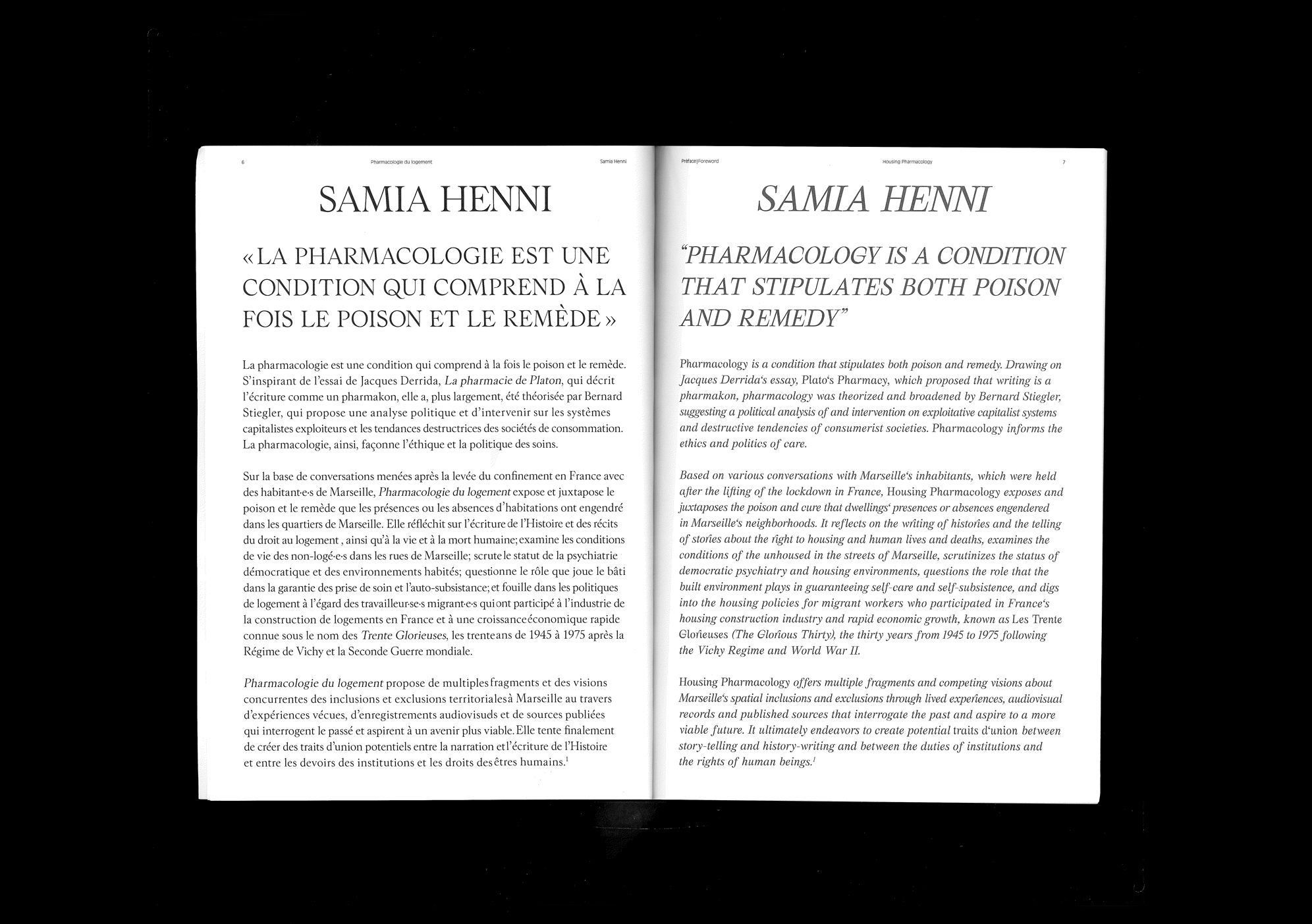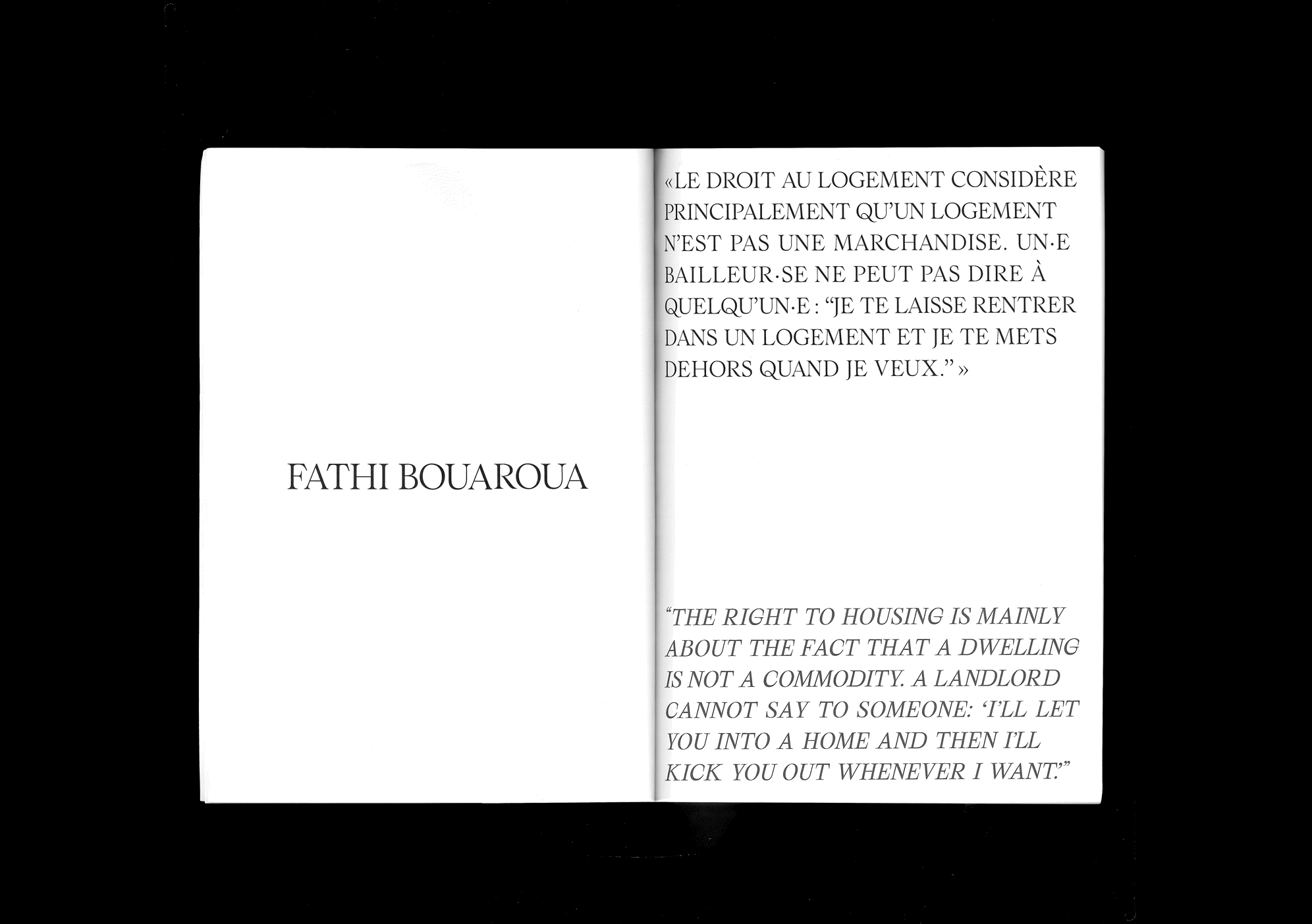2020(FR)
Pharmacologie du logement
Publication for the architect and researcher Samia Henni for the Biennale Manifesta 13, Marseille(FR).
The 136 pages publication was part of the exhibition “Pharmacologie du logement – Housing pharmacology” (11.09.20 – 29.11.20) at the Musée d’Histoire de Marseille. It gathers seven conversations led by Samia Henni with inhabitants of Marseille, just after the lockdown was lifted in France.
The 136 pages publication was part of the exhibition “Pharmacologie du logement – Housing pharmacology” (11.09.20 – 29.11.20) at the Musée d’Histoire de Marseille. It gathers seven conversations led by Samia Henni with inhabitants of Marseille, just after the lockdown was lifted in France.

Publication
Samia Henni is an architect and researcher. Her work is related to colonisation, deserts, displacement, gender, migration, resources exploitation, and wars.
“Pharmacology is a condition that stipulates both poison and remedy. (…) suggesting a political analysis of and intervention on exploitative capitalist systems and destructive tendencies of consumerist societies.“
Throughout a period of lockdown or curfew, what have governments planned for people without stable housing ? How do we address questions of isolation for those already pushed to the margin? How do we protect essential workers? To whom is given the responsibility of controlling these specific restrictive measures?
“Pharmacology is a condition that stipulates both poison and remedy. (…) suggesting a political analysis of and intervention on exploitative capitalist systems and destructive tendencies of consumerist societies.“
Throughout a period of lockdown or curfew, what have governments planned for people without stable housing ? How do we address questions of isolation for those already pushed to the margin? How do we protect essential workers? To whom is given the responsibility of controlling these specific restrictive measures?




These questions are as essential as the workers who provide the beginning of an answer. This publication gathers 7 conversations with inhabitants of Marseille. Bus drivers, social workers, associative collectives, speak about solidarity, mutual assistance, and being attentive, but also about abandonment and responsibility. A police officer is also interviewed, his discourse raises questions of incarceration, stigmatisation and of whom obtains the legitimacy of the usage of force and control.
This project is an installation of seven conversations led by Samia Henni with Marseille’s essential workers just after the first lockdown of March 2020 was lifted in France. Through photographs, voices and a publication, the installation exposes the Housing Pharmacology in Marseille’s neighborhoods –pre and during lockdown– as well as the history of the right to housing, showing diverse perspectives on Marseille spatial inclusion and exclusions.
This project is an installation of seven conversations led by Samia Henni with Marseille’s essential workers just after the first lockdown of March 2020 was lifted in France. Through photographs, voices and a publication, the installation exposes the Housing Pharmacology in Marseille’s neighborhoods –pre and during lockdown– as well as the history of the right to housing, showing diverse perspectives on Marseille spatial inclusion and exclusions.


Completely bilingual (FR/EN), the layout avoids hierarchy from a conversation to another. The choice of images was also made to prevent stereotypes and decontextualisation when showing homelessness or free shelters. The visual processing was done by Samia Henni.
To allow readibility and distinction between languages, we worked with Marya, a serif, well-balanced font designed by Margot Levêque and Kéroïne Intense Légère, a slanted font, part of the care set font family, designed by Charlotte Rohde. The footnotes use Antique Olive in both languages, an emblematic font design by Roger Excoffon (1919-1983) as part of Olive Foundry, which was located 28 rue de l’Abbé-Féraud in Marseille, from 1836 to 1978.
–
Bienale Manifesta 13, curated by Alya Sebti, Katerina Chuchalina and Stefon Kalmarat, with the help of Flora Fettah (Traits d’Union.s). Museum of Marseille History.
To allow readibility and distinction between languages, we worked with Marya, a serif, well-balanced font designed by Margot Levêque and Kéroïne Intense Légère, a slanted font, part of the care set font family, designed by Charlotte Rohde. The footnotes use Antique Olive in both languages, an emblematic font design by Roger Excoffon (1919-1983) as part of Olive Foundry, which was located 28 rue de l’Abbé-Féraud in Marseille, from 1836 to 1978.
–
Bienale Manifesta 13, curated by Alya Sebti, Katerina Chuchalina and Stefon Kalmarat, with the help of Flora Fettah (Traits d’Union.s). Museum of Marseille History.



Crédit photo: Jean-Christophe Lett / Manifesta 13 Marseille
© 2024